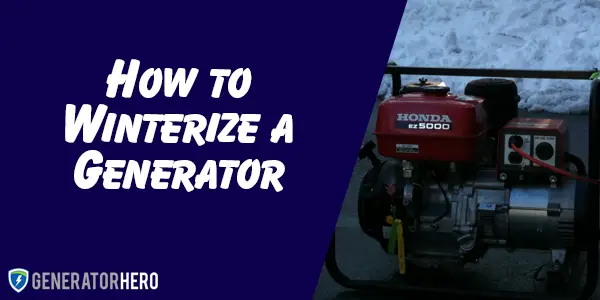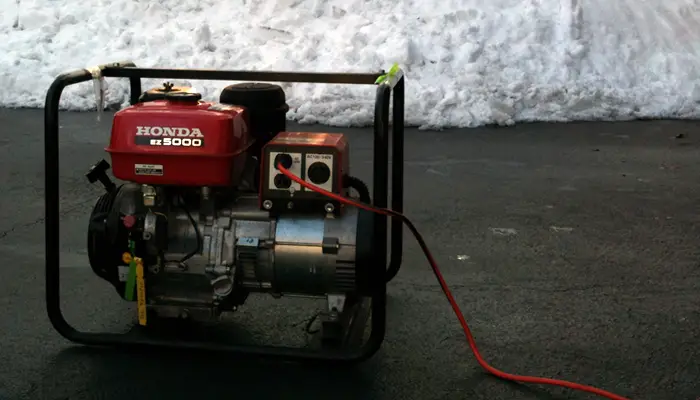Fall is here, and many of you with RVs will spend the last few autumn weekends enjoying the brisk weather around campfires. As you layer on extra clothes to stay warm, don’t forget to winterize your portable generator before the snow and frigid temps arrive. Winter is just around the corner. Taking time to care for your generator when you resume your camping trips next spring will make you happy.
You want your generator to work when you need it, so its care is an essential priority. A standby generator stands by quietly until required to provide electricity during a power outage in homes and businesses.
Winter happens, and temperatures across the US vary, but preparation will ensure that your generator will be ready. Your power can go out if the temperature is below freezing, so make sure your generator is prepared to work to keep your family warm and toasty.
Winterizing your generator provides peace of mind. Winter weather can bring ice and snowstorms that cause outages, so preparing the generator to handle the cold will give you mental comfort in addition to powering lights and heat for physical comfort.
Table of Contents
How to Winterize a Seasonal Portable Generator
Your generator has provided power for your camping excursions. Now it is time for the RV and camping gear storage for the winter months. Winterizing your generator before you store it will ensure that it will be waiting to work again next season.
1. Drain the fuel lines
While freezing weather will not affect your generator too much, you must drain the fuel lines and tank before storing. Gasoline in fuel lines and tanks can erode without use within about ten days, stopping the carburetor.
2. Clean the Carburetor
Clean the carburetor at the end of the season to remove any sludge that has accumulated.
3. Change Oil & Filter
Another task will be to change the oil and filter. The fresh oil will keep the parts lubricated over the winter. Remember that oil has viscosity grades to meet certain temperatures. When changing the oil for the winter, make sure you use an oil designed to work at low and freezing temperatures.
Cold weather changes the viscosity of oil and makes it more difficult to flow. If your generator has a low oil sensor, it can signal the generator to shut down. Make sure you are using a winter-grade oil that is thinner to flow easier. Check your owner’s manual for its recommendations.
4. Remove the Spark Plug
Some manufacturers suggest removing the spark plug and plugging the opening, so dust or debris don’t enter.
If you have a dual-fuel generator and have only run LPG, it isn’t necessary to clean the carburetor, fuel lines, or tank. However, if you have run the generator on both fuels, you must clean the tank, inspect the lines, and clean the carburetor. Propane will not leave residue in the lines as it burns relatively clean. Disconnect propane before storing.
Do not leave your generator unprotected where snow and ice can damage it, as melting ice and snow can cause rust and corrosion of its parts. Store your generator in a dry shed, garage, or another shelter. If that is not possible, place it on a pallet or similar foundation to keep it above a water line, then cover it securely with a tarp.

Preparing Your Home or Business Generators
There is maintenance work to ensure your portable or standby generator will continue to work through the winter.
Winterizing a Standby Generator
Often standby generators are placed near a home or business with bushes or gardens planted around them as camouflage. As plants grow, they can encroach on the generator and obstruct air intake and flow.
1. Clear Surrounding Brush
It is a good idea to clear the generator’s area, as this will also give clear access for maintenance. Dead foliage left near the generator can ignite and cause a fire.
2. Schedule a Routine Tune-up & Cleaning
The next step is to call a professional to perform a routine tune-up. The service technician will inspect all the components, clean those, change the fluids, and run them to diagnose any potential issues.
The technician will also check the battery to ensure that the automatic start feature will work when needed. Cold weather is not a friend of batteries, so we recommend periodic checks of their voltage. If the battery remains low, it may be time to change it before cold weather begins.
3. Install a Battery Warmer
Another way to avoid cold weather battery drain and maintain power to start your generator is to install a battery warmer. When the temperature reaches a certain degree, the battery warmer turns on and keeps the battery from losing power.
4. Run it Periodically
Most standby generators automatically start monthly for 15 minutes. If yours does not, schedule a day each month and remember to start it up. This regular action keeps the parts lubricated and operational when you need them.
How to Winterize a Year-Round Generator
As you use your portable generators, the fuel and oil get dirty and collect in the lines and carburetor. The engines require regular maintenance to clean, check lines, and replace parts as needed. If you haven’t done this during the season, winterizing is the time to get it done.
Following the recommended maintenance guidelines, you can ensure that your generator will be operational throughout the winter.
Either call a professional technician to service your generator or perform your routine tune-up. Inspect all the components, clean those, change the fluids, and run them to diagnose any potential issues. Consider winter fuel additives (if the manufacturer recommends) and change the oil to a winter-grade to help your generator run in the cold.
Cold weather is not a friend of batteries. If your generator has an electric start, check the battery to ensure that the automatic start feature works when needed. Periodic tests of the battery voltage are highly recommended. If the battery remains low, change it before cold weather begins.
As stated, snow and ice can damage your generator. A generator shelter is the best protection to keep your generator safe from moisture that can cause corrosion of lines and components. Check the exhaust port and vents periodically to make sure ice and snow have not obstructed those.
Check Exhaust and Air Vents
Remember that your generator’s engine needs airflow to operate efficiently. It is not uncommon for exhaust ports and air vents to become obstructed by ice dams or snow buildup during the winter. Heavy snow can cover those areas, and as freezing/thawing occurs, build up to block access. Regular visual checks to remove any accumulation will avoid problems.
Block Heater
If you live in an area where temperatures can drop below zero for extended periods, you may want to consider an engine block heater. The heater is also known as a water jacket heater. It assists with cold starts by keeping the engine and oil warm. A note of caution – not every engine block heater will work with every generator. Always check the manufacturer’s recommendations for the right fit.

Conclusion
Although winterizing your generator is a good plan, freezing temperatures can still pose problems. Maintenance and regular operation of the generator can help to avoid any starting issues. Remember that fresh fuel, winter-grade oil, and good batteries will give you a better chance of success when your power fails.
Always refer to any winter recommendations in the generator owner’s manual. Every make /model is different, so there is no one-size-fits-all way to winterize your generator.
FAQ
How do you store a generator for the winter?
If you do not plan to use the generator, you should winterize it by draining the fuel tank, clearing the lines, cleaning the carburetor, and changing the oil. Some manufacturers recommend removing the spark plug. Once fuels are drained, and winter oil is added, check all components for signs of wear. Replace as needed. Store the generator in a dry shed, garage, or another shelter. If those options are unavailable, secure the generator with a tarp after placing it on a pallet or other foundation to keep it above any water that may flow with snowmelt.
Refer to the generator owner’s manual for directions on winterizing your make and model.
How do you winterize a gas generator?
You can winterize a gas-powered generator by draining the fuel tank, clearing the lines, cleaning the carburetor, and changing the oil. Some manufacturers recommend removing the spark plug. Once fuels have been drained and winter oil is added, check all components for signs of wear. Replace as needed. Store the generator in a dry shed, garage, or another shelter. If those options are not available, secure the generator with a tarp after placing it on a pallet or other foundation to keep it above any water that may flow with snowmelt
Refer to the generator owner’s manual for directions on winterizing your make and model.
Is it OK to leave a generator out in the snow?
No. Moisture in any form is not a friend of generators. After winterizing a generator, store it in a dry shed, garage, or another shelter. If it is not possible to keep it in a building, securely wrap it with a tarp after placing it on a pallet or other foundation. This prevents any water that may flow from melting snow.
